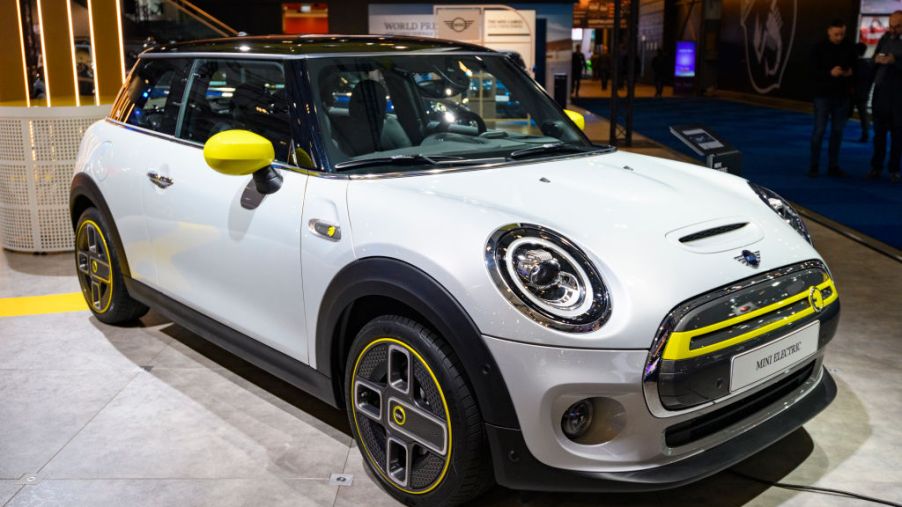
The 2020 Mini Cooper SE Hardtop’s Poor Range Might Not Be a Bad Thing
While Mini has been making the Countryman Plug-in Hybrid for a couple of years now, the 2020 Mini Cooper SE is its first-ever all-electric vehicle. The automaker is well-known for making vehicles that are fun to drive, fairly expensive, and — hence the name — small. The Mini Cooper SE stays true to the brand in that it’s diminutive and a blast to drive, but it’s rather affordable. One of the most affordable EVs, in fact.
Although its attractive price point and driveability are certainly selling points, the Cooper SE’s range matches its tiny footprint, which could be a drawback to some.
The marvelous Mini Cooper SE
Being that BMW is Mini’s parent company, it makes perfect sense that the Mini Cooper SE has the same engine as the BMW i3. The 181 hp and all-electric technology make the Cooper SE lightning fast off the line. 0-to-60-mph-in-6.9-seconds fast, to be exact.
Inside the Mini Cooper SE, the ride is exceptionally quiet. Notably (and unusually) for an EV, the T-shaped battery doesn’t take up any space in the cabin, because it’s tucked inconspicuously under the rear seats and down the middle of the car. And although it’s small, the SE’s seats slide and adjust to accommodate longer legs.
Even the base Signature trim SE comes standard with desirable features including heated seats and mirrors, leatherette upholstery, LED headlights, and Apple CarPlay. Sorry Android users, no Android Auto. Curiously, adaptive cruise control isn’t available on any trim level.
While there’s plenty to love about the Mini Cooper SE, the most attractive thing about it is its price point. As Car and Driver stated, “The Cooper SE’s $30,750 entry point makes it less expensive than even the Hyundai Ioniq Electric, a car that’s way less fun to drive and barely goes any farther on a charge.” That MSRP is before the $7,500 federal tax credit and any additional tax credits offered by individual states.
How the Mini Cooper SE’s range stacks up
Although the Mini Cooper SE’s small 32.6-kWh battery has its advantages, it has one major drawback – it allows for just a 110-mile range. By comparison, the Chevrolet Bolt has a range of up to 259 miles, and even the Mini Cooper SE’s cousin, the i3, can go up to 153 miles.
In electric vehicle marketing, there’s a great deal of focus placed on driving range, but consider how much you really drive. According to the Federal Highway Administration, Americans drive 13,476 miles per year — or just over 36 miles per day. Based on that, the Mini Cooper SE’s range is more than adequate.
Making a 110-mile range work for you
Fortunately, EV charging methods and capabilities have come a long way. The 2020 Mini Cooper SE comes with a TurboCord charger that can plug into any standard 3-prong 120V outlet and charge a fully-depleted battery in eight hours. Even using this most basic charger, if the Cooper SE is charged nightly, it gets over 700 driving miles per week or over 36,000 annually. Looking again at the Federal Highway Administration’s data, very few people drive that much.
If you upgrade to a Level 2 240V charger, which is what many household appliances use, the Mini Cooper SE can be fully charged in about four hours. When you consider the fact that with an electric vehicle, you are completely eliminating trips to the gas station and getting oil changes, the inconvenience of plugging the car in nightly is a favorable tradeoff.
For longer trips, there are public DC fast-charging stations throughout the world, and more are constantly being built. These stations can charge a battery to about 80% in as little as 40 minutes, but it’s worth noting that it’s significantly more expensive to charge an EV this way. According to Cars.com, using a fast charger on the go costs about $.09 per mile, whereas charging at home costs just $.03 per mile.
Although the Mini Cooper SE has a much smaller range than most of its competitors, it’s truly only a minor issue. This is a fantastic car at an even more fantastic price that’s worth serious consideration.


